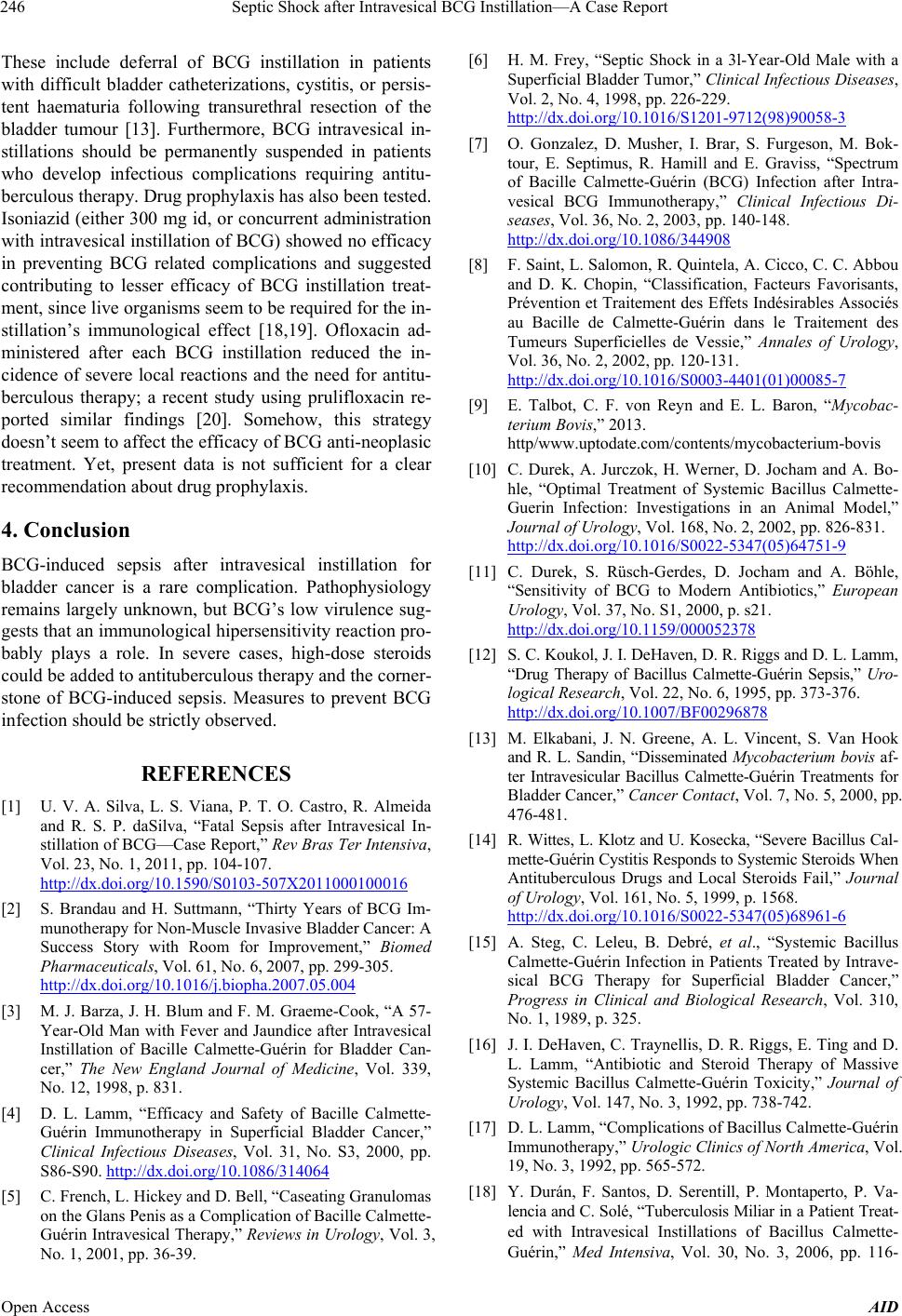
Septic Shock after Intravesical BCG Instillation—A Case Report
246
These include deferral of BCG instillation in patients
with difficult bladder catheterizations, cystitis, or persis-
tent haematuria following transurethral resection of the
bladder tumour [13]. Furthermore, BCG intravesical in-
stillations should be permanently suspended in patients
who develop infectious complications requiring antitu-
berculous therapy. Drug prophylaxis has also been tested.
Isoniazid (either 300 mg id, or concurrent administration
with intravesical instillation of BCG) showed no efficacy
in preventing BCG related complications and suggested
contributing to lesser efficacy of BCG instillation treat-
ment, since live organisms seem to be required for the in-
stillation’s immunological effect [18,19]. Ofloxacin ad-
ministered after each BCG instillation reduced the in-
cidence of severe local reactions and the need for antitu-
berculous therapy; a recent study using prulifloxacin re-
ported similar findings [20]. Somehow, this strategy
doesn’t seem to affect the efficacy of BCG anti-neoplasic
treatment. Yet, present data is not sufficient for a clear
recommendation about drug prophylaxis.
4. Conclusion
BCG-induced sepsis after intravesical instillation for
bladder cancer is a rare complication. Pathophysiology
remains largely unknown, but BCG’s low virulence sug-
gests that an immunological hipersensitivity reaction pro-
bably plays a role. In severe cases, high-dose steroids
could be added to antituberculous therapy and the corner-
stone of BCG-induced sepsis. Measures to prevent BCG
infection should be strictly observed.
REFERENCES
[1] U. V. A. Silva, L. S. Viana, P. T. O. Castro, R. Almeida
and R. S. P. daSilva, “Fatal Sepsis after Intravesical In-
stillation of BCG—Case Report,” Rev Bras Ter Intensiva,
Vol. 23, No. 1, 2011, pp. 104-107.
http://dx.doi.org/10.1590/S0103-507X2011000100016
[2] S. Brandau and H. Suttmann, “Thirty Years of BCG Im-
munotherapy for Non-Muscle Invasive Bladder Cancer: A
Success Story with Room for Improvement,” Biomed
Pharmaceuticals, Vol. 61, No. 6, 2007, pp. 299-305.
http://dx.doi.org/10.1016/j.biopha.2007.05.004
[3] M. J. Barza, J. H. Blum and F. M. Graeme-Cook, “A 57-
Year-Old Man with Fever and Jaundice after Intravesical
Instillation of Bacille Calmette-Guérin for Bladder Can-
cer,” The New England Journal of Medicine, Vol. 339,
No. 12, 1998, p. 831.
[4] D. L. Lamm, “Efficacy and Safety of Bacille Calmette-
Guérin Immunotherapy in Superficial Bladder Cancer,”
Clinical Infectious Diseases, Vol. 31, No. S3, 2000, pp.
S86-S90. http://dx.doi.org/10.1086/314064
[5] C. French, L. Hickey and D. Bell, “Caseating Granulomas
on the Glans Penis as a Complication of Bacille Calmette-
Guérin Intravesical Therapy,” Reviews in Urology, Vol. 3,
No. 1, 2001, pp. 36-39.
[6] H. M. Frey, “Septic Shock in a 3l-Year-Old Male with a
Superficial Bladder Tumor,” Clinical Infectious Diseases,
Vol. 2, No. 4, 1998, pp. 226-229.
http://dx.doi.org/10.1016/S1201-9712(98)90058-3
[7] O. Gonzalez, D. Musher, I. Brar, S. Furgeson, M. Bok-
tour, E. Septimus, R. Hamill and E. Graviss, “Spectrum
of Bacille Calmette-Guérin (BCG) Infection after Intra-
vesical BCG Immunotherapy,” Clinical Infectious Di-
seases, Vol. 36, No. 2, 2003, pp. 140-148.
http://dx.doi.org/10.1086/344908
[8] F. Saint, L. Salomon, R. Quintela, A. Cicco, C. C. Abbou
and D. K. Chopin, “Classification, Facteurs Favorisants,
Prévention et Traitement des Effets Indésirables Associés
au Bacille de Calmette-Guérin dans le Traitement des
Tumeurs Superficielles de Vessie,” Annales of Urology,
Vol. 36, No. 2, 2002, pp. 120-131.
http://dx.doi.org/10.1016/S0003-4401(01)00085-7
[9] E. Talbot, C. F. von Reyn and E. L. Baron, “Mycobac-
terium Bovis,” 2013.
http/www.uptodate.com/contents/mycobacterium-bovis
[10] C. Durek, A. Jurczok, H. Werner, D. Jocham and A. Bo-
hle, “Optimal Treatment of Systemic Bacillus Calmette-
Guerin Infection: Investigations in an Animal Model,”
Journal of Urology, Vol. 168, No. 2, 2002, pp. 826-831.
http://dx.doi.org/10.1016/S0022-5347(05)64751-9
[11] C. Durek, S. Rüsch-Gerdes, D. Jocham and A. Böhle,
“Sensitivity of BCG to Modern Antibiotics,” European
Urology, Vol. 37, No. S1, 2000, p. s21.
http://dx.doi.org/10.1159/000052378
[12] S. C. Koukol, J. I. DeHaven, D. R. Riggs and D. L. Lamm,
“Drug Therapy of Bacillus Calmette-Guérin Sepsis,” Uro-
logical Research, Vol. 22, No. 6, 1995, pp. 373-376.
http://dx.doi.org/10.1007/BF00296878
[13] M. Elkabani, J. N. Greene, A. L. Vincent, S. Van Hook
and R. L. Sandin, “Disseminated Mycobacterium bovis af-
ter Intravesicular Bacillus Calmette-Guérin Treatments for
Bladder Cancer,” Cancer Contact, Vol. 7, No. 5, 2000, pp.
476-481.
[14] R. Wittes, L. Klotz and U. Kosecka, “Severe Bacillus Cal-
mette-Guérin Cystitis Responds to Sy stemic Steroids When
Antituberculous Drugs and Local Steroids Fail,” Journal
of Urology, Vol. 161, No. 5, 1999, p. 1568.
http://dx.doi.org/10.1016/S0022-5347(05)68961-6
[15] A. Steg, C. Leleu, B. Debré, et al., “Systemic Bacillus
Calmette-Guérin Infection in Patients Treated by Intrave-
sical BCG Therapy for Superficial Bladder Cancer,”
Progress in Clinical and Biological Research, Vol. 310,
No. 1, 1989, p. 325.
[16] J. I. DeHaven, C. Tray nellis, D. R. Riggs, E. Ting and D.
L. Lamm, “Antibiotic and Steroid Therapy of Massive
Systemic Bacillus Calmette-Guérin Toxicity,” Journal of
Urology, Vol. 147, No. 3, 1992, pp. 738-742.
[17] D. L. Lamm, “Complications of Bacillus Calmette-Guérin
Immunotherapy,” Urologic Clinics of North America, Vol.
19, No. 3, 1992, pp. 565-572.
[18] Y. Durán, F. Santos, D. Serentill, P. Montaperto, P. Va-
lencia and C. Solé, “Tuberculosis Miliar in a Patient Treat-
ed with Intravesical Instillations
of Bacillus Calmette-
Guérin,” Med Intensiva, Vol. 30, No. 3, 2006, pp. 116-
Open Access AID